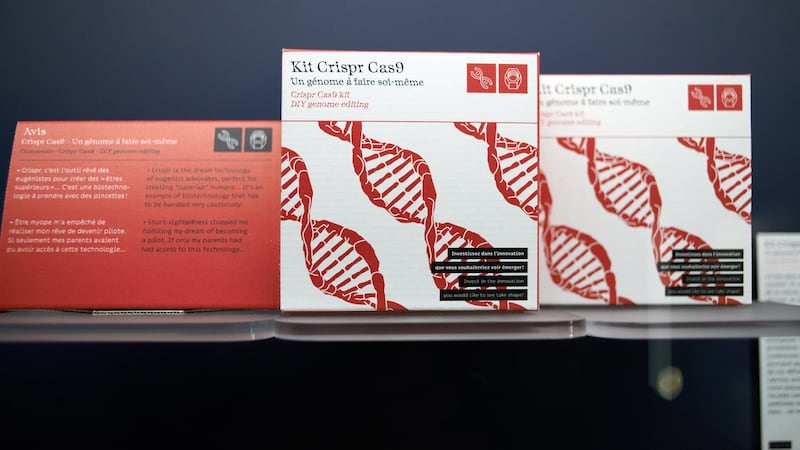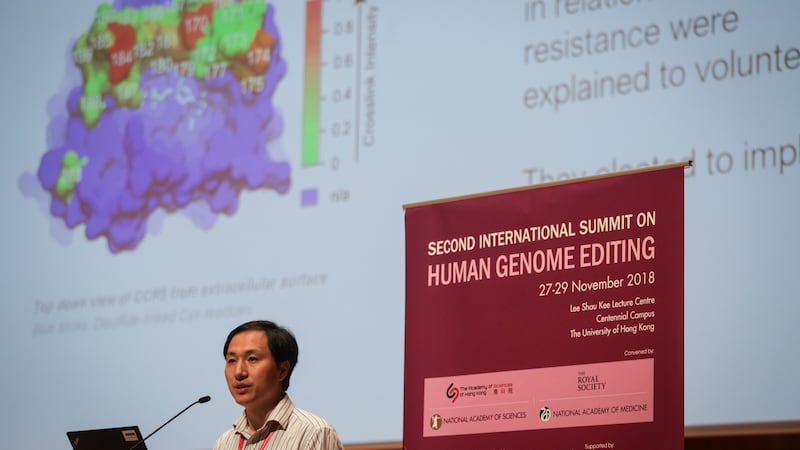Earlier this month, readers of The Irish Times voted gene editing as the innovation of the last decade, beating competition such as the cloud, smartphones and social media. While gene editing (like the other innovations) has been in the works for a while, the last seven years have seen major developments in our ability to specifically edit DNA in living cells.
It is not without controversy. Recent claims that human embryos in China had been genetically edited and had resulted in twin babies prompted widespread condemnation from scientists, as well as discussions about safety and ethics and calls for effective regulation.
But as a technology, the ability to alter a gene in a living cell offers many potential benefits, including treating inherited diseases, understanding what specific genes do, generating more resilient crops and even detecting species in the environment.
"The field is amazing," says Jane Farrar, a professor of genetics at Trinity College Dublin. "I have had some very late nights updating my lecture slides for undergraduates, because so much in gene technology is happening so quickly."
Gene editing – which directly changes the “letters” of the genome – is becoming more of a feature of gene therapy, notes Farrar, but it is the new kid on the block. “The ability to edit specific genes in living cells is relatively new,” she says. “That means many forms of gene therapy that have by now reached the clinic or are under late-stage development don’t use these new gene-editing techniques. They deliver the gene into the cell, rather than correcting or editing the DNA,” she notes.
Farrar was one of the pioneers of gene therapy research in Ireland in the 1980s and 1990s, when the patient-led charity Fighting Blindness supported work to find the genetic changes linked to inherited forms of vision loss.
“The eye is really an ideal place for gene therapy,” she explains. “It is accessible, it can tolerate the viruses used to deliver genes and you have a natural control – if you put the gene therapy in one eye you can compare it to the other over time.”
Rare eye disease
Farrar, Prof Pete Humphries and colleagues identified gene changes involved in a rare eye disease called retinitis pigmentosa, and developed a system to "rescue" the gene function by suppressing the mutant gene and delivering a new gene into the cell. The technology was acquired by Spark Therapeutics in 2016.
In 2017, the FDA in the USA approved a different Spark therapy, Luxturna, which replaces the function of gene changes associated with progressive sight loss. It was the first gene therapy of its kind to be approved in the US.

“In general, there’s a huge amount of commercial interest in new gene therapies,” says Farrar. “Plenty more are in the works, not just for inherited eye diseases but also for rare diseases that affect how cells break down cellular components to recycle them, conditions that damage the mitochondria [which act as “batteries” in cells] and spinal and central nervous system disorders, among others.”
She believes that gene editing will become more common in gene therapy approaches in the coming years, particularly as we work out how to do it safely and effectively. “With gene editing, there is the potential risk of ‘off-targets’, where editing a target gene could bring about unintentional changes in the genome or cell function, so some researchers are looking for ‘safe harbours’ in DNA,” she explains. “These are stretches of DNA where in principle you could add different genes targeting different disorders, while avoiding negative off-target effects.”
The availability of gene editing in recent years also means that scientists can now use it as a research tool to target specific stretches of DNA relatively easily, according to Prof Breandan Kennedy, a senior lecturer at University College Dublin.
Probably the best known gene-editing technology is CRISPR-Cas9, which was made commercially available in 2012. A little like having a sat-nav and a scissors, CRISPR-Cas systems allows you target a specific sequence of DNA “letters” in a living cell, then cut the sequence at that point.
‘Very powerful’
“By doing this, we can inactivate a specific gene, and this gives us a lot of information about what that gene normally does,” says Kennedy, whose work at UCD school of biomolecular and biomedical science uses gene editing technology on microscopic worms, zebrafish and human cells in the lab.
“By inactivating specific genes, which we can do much more quickly and easily now with CRISPR-Cas systems, our group has been able to identify genes that are important for vision, for eye development and for blood vessels in the eye to grow and work properly. We are also using the approach to validate in the lab whether particular DNA change in patients are involved in inherited eye disease. Ten years ago if you said such a technology would be widespread, people would have laughed, but now labs around the world can do this. It’s very powerful.”
Plant science, too, is reaping the rewards of being able to target specific stretches of DNA in living cells. "What is possible now is what was impossible five years ago," says Dr Ewen Mullins, head of the crop science department at Teagasc, Oak Park.

“The holy grail for plant breeding is to be able to control the activity of a single gene, or several linked genes, and now gene editing allows us to do that,” he says. “And crucially, we are not necessarily adding a gene in from another species. With CRISPR-Cas systems, we can edit the genes already in the plant.”
This could help to make crop plants more resilient in the face of droughts, fluctuating temperatures and agents of disease, notes Mullins: “These are becoming issues for farmers in Ireland and other parts of the world now, and in the face of climate change we need to reduce those susceptibilities where we can into the future.”
Identifying species
Gene-editing technology can even help us to identify what species are living in a particular environment, as Dr Anne Parle-McDermott from Dublin City University is finding out. "We are looking at the different species of salmon that live in rivers and aquaculture, but we are doing that by analysing the DNA they shed, also known as environmental or e-DNA," she explains. "We can take a sample of water, then we add CRISPR to find unique stretches of DNA that tell us about the species it came from. The associated Cas protein then cuts a reporter DNA and we can detect that cutting activity, so we know that stretch of DNA is present in the sample. It gives us a whole new way of knowing what DNA is present in the environment."
Dr Ciaran Seoighe, deputy director general at Science Foundation Ireland, is impressed that gene technology won the reader vote for the innovation of the decade. "CRISPR-Cas9 is a case of a discovery turned into an innovation," he says. "Decades ago, researchers were discovering that bacteria had this system of being able to find and cut DNA in viruses and so stop them attacking, and the innovation was to take that and use it to specifically edit genes ourselves. It was a case of finding something interesting and then doing something different with it. Now it provides a tool for researchers to work on more personalised approaches to medicine."
Farrar is also impressed by the winning vote. “I think the readers are very insightful,” she says. “Gene technology has matured in the last decade, and thanks to gene-editing technology we can also now get far more understanding about disease. This is really a story of fundamental biology enabling a new technology. Without that curiosity, we might not have these exciting innovations now.”













